You’ve probably heard about Minnesota’s efforts to protect the night sky. These initiatives aren’t just for hardcore astronomers; they’re for anyone who enjoys the beauty of a natural, dark sky.
But, finding the right spots for stargazing and understanding the technicalities of dark skies can be challenging. How do you navigate through these initiatives to find those perfect starry views?
In this article, I’ll guide you through the nuances of Minnesota’s Dark Sky Initiatives. From understanding the role of the International Dark-Sky Association to discovering the best dark sky places and events in Minnesota, you’ll find all the information you need to enjoy the night sky to its fullest.
Key Things to Know:
- Voyageurs National Park is a certified Dark Sky Park, ideal for stargazing.
- The impact of light pollution and conservation strategies are crucial for a clear sky.
- Night photography requires specific gear and techniques for capturing stars.
- Seasonal events like meteor showers offer unique viewing opportunities.
Understanding the Minnesota Dark Sky Map

Minnesota is taking significant steps to protect the night sky. Whether you love gazing at stars or enjoying the natural dark, you’ll find these efforts pretty cool.
Role of the International Dark-Sky Association
I’ve come to appreciate the IDA’s role in safeguarding our night skies from light pollution deeply in my stargazing adventures.
How does this work? The IDA recognizes places excellent for stargazing and where skies are kept dark. This helps you know where to go for the best starry views. They also help guide the efforts to keep these skies dark.
Certified Dark Sky Places in Minnesota
In Minnesota, there’s a spot that’s officially great for stargazing. It is recognized by the IDA as an International Dark Sky Park called Voyageurs National Park.
What does it mean to be certified? Well, it means:
- It’s one of the best places in Minnesota to see a clear night sky.
- There are special programs to learn more about the stars.
If you’re curious about dark skies in Minnesota, check out these places:
- Minnesota Dark Sky Parks
- Bortle Light Pollution Maps
Now grab a blanket, find yourself in a dark spot, and look up!
Top Stargazing Locations and Events
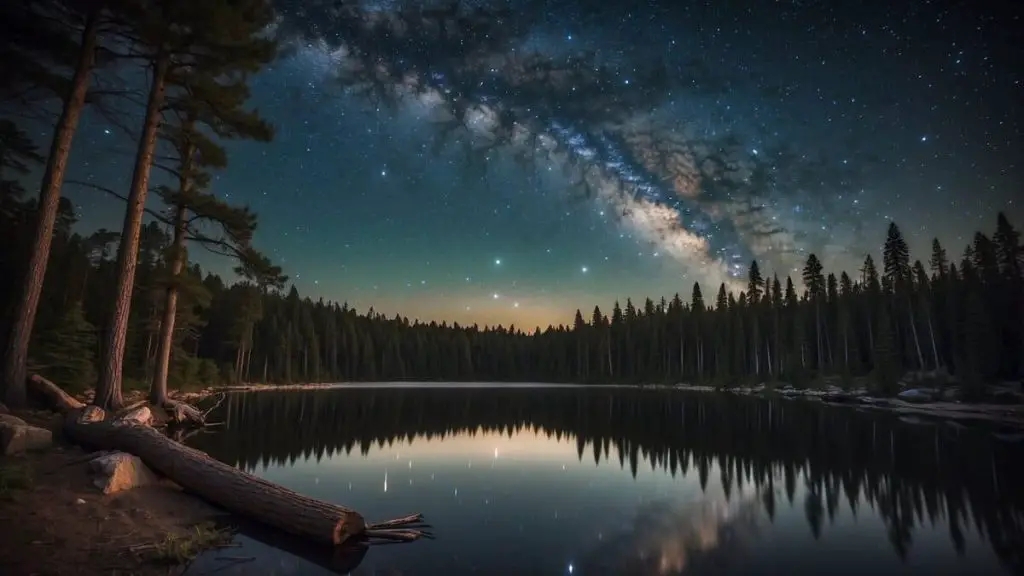
Minnesota is a treasure trove for night sky enthusiasts. Here, you can find some of the clearest dark skies, perfect for looking up and getting lost in the stars.
Boundary Waters Canoe Area Wilderness
The Boundary Waters Canoe Area Wilderness is your escape into over a million acres of forest. It’s a natural wonder by day, and by night, it becomes a stargazer’s paradise.
Here’s what you need to know:
- Privacy: You get a truly dark night sky with few artificial lights. The darkness enhances the visibility of the stars, making it a stargazer’s paradise.
- Accessibility: You can reach viewing spots by canoe or on foot.
Voyageurs National Park and Surroundings
At Voyageurs National Park, the sky comes alive after sunset. It’s known for its:
- Quality Dark Skies: Certified as an International Dark Sky Park, it’s one of the best in the state.
- Stargazing Programs: Park rangers often host events to help you explore the night sky.
Check out the park’s official information to learn more about their stargazing programs.
Star Parties and Astronomy Events
Are you ready to mingle with fellow astronomy fans? Join a star party! Consider these spots:
- Baylor Regional Park: Home to Eagle Lake Observatory, it’s great for family-friendly star parties.
- Local Clubs: Astronomy clubs often hold events where you can learn to navigate the stars.
Watch local astronomy group calendars to catch these fun and educational events.
By visiting these spots and attending events, you can enjoy Minnesota’s dark skies to their fullest!
FREE STARGAZING CHECKLIST
My 5-page Stargazing Checklist will enhance your astronomical observations.
Follow this free checklist to navigate the night sky with confidence, clarity, and a sense of preparedness for a rewarding stargazing experience.

Photography Tips for Capturing the Night Skies
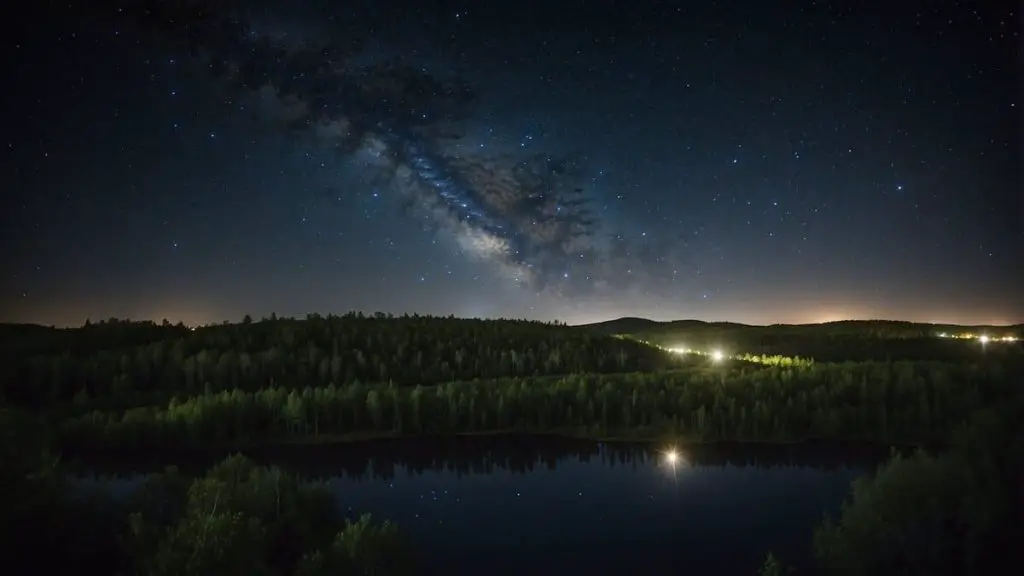
Capturing the breathtaking night skies takes some know-how and the right gear. Below, you’ll find straightforward advice on what you need and how to best use it for stunning night sky photos.
Night Sky Photography Equipment Essentials
- Camera: A digital SLR or mirrorless camera is your best bet. In my experience, these cameras’ manual settings are crucial for capturing the perfect night sky shot. Features like a high ISO range can help you get clear shots of stars and the Milky Way.
- Lenses: Wide-angle lenses are great for capturing expansive night sky views and constellations. Look for ones with large apertures (like f/2.8) to let in more light.
- Tripod: A sturdy tripod is a must. It keeps your camera stable for long exposures, which means sharp night sky pictures.
- Telescope: For close-up shots of celestial objects, a telescope that can attach to your camera will work wonders.
- Smartphone: Even your phone can snap night sky photos. Use a night photography app and a tripod to help your smartphone capture the stars.
Best Practices for Night Photography
- Plan Your Shoot: Aim for nights when the sky is darkest, often during a new moon or in areas with minimal light pollution.
- Manual Settings: Switch your camera to manual mode. Adjust the ISO, aperture, and shutter speed to allow the right amount of light for the scene.
- Focus: Put your lens in manual focus and set it to infinity. This helps keep the stars as sharp points rather than blurry spots.
- Experiment: Try different settings to see what works best. Remember, longer exposures capture more starlight but can also show Earth’s rotation as star trails.
- Keep Warm: Nights can get cold, so dress warmly to stay comfortable while you wait for that perfect shot.
In my experience, capturing the night skies requires as much preparation and patience as the right equipment. With these tips, you’re set to take some amazing photographs of the night sky.
Impact of Light Pollution and Conservation Efforts
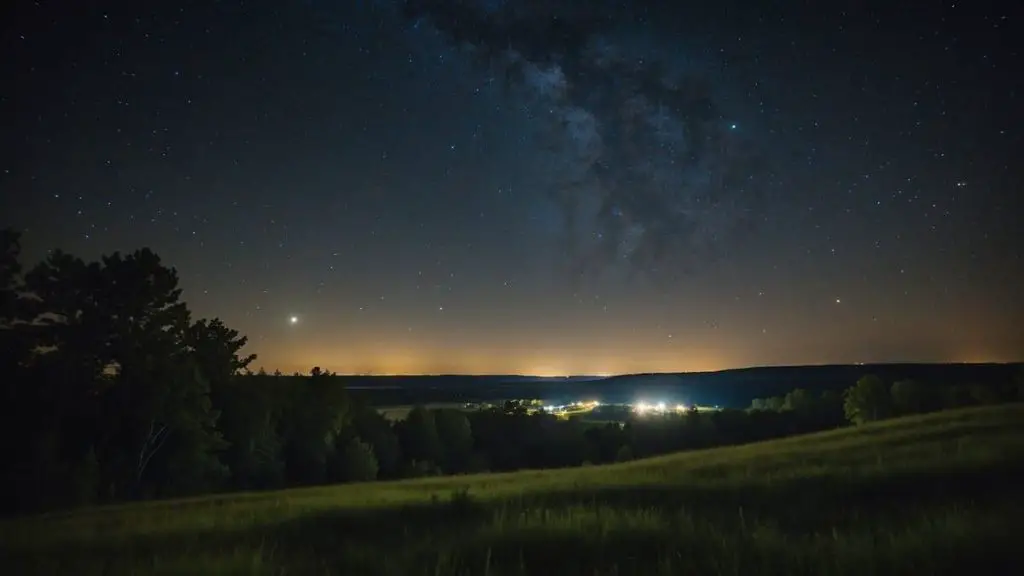
Light pollution affects the night skies and the well-being of ecosystems. I’ve seen how reducing light pollution can dramatically improve the quality of the night sky. To tackle this problem, knowing how to measure light pollution and ways to reduce it are essential.
Understanding the Bortle Scale

The Bortle Scale is a way to measure the brightness of the night sky in a specific place. It ranges from 1 to 9, with 1 being the darkest and 9 filled with bright city lights. The darker the sky, the more stars you can see. For instance, in some Minnesota Dark Sky Parks, you may find ratings closer to 1 or 2, ideal for stargazing.
Mitigation Strategies for Businesses and Residents
Both businesses and residents can help in reducing light pollution. Here are a few steps you can take:
- Switch to LED lights: They save energy and can be directed to reduce skyglow.
- Use motion sensors: Install them so lights turn on only when needed.
- Support IDA efforts: The International Dark-Sky Association (IDA) helps raise awareness and provides solutions to conserve dark skies.
- Educate others: Share what you know about light pollution with your neighbors.
By taking these actions, you can help preserve the night sky and protect the animals and ecosystems affected by light pollution.
Seasonal and Astronomical Highlights to Observe

Minnesota’s dark skies offer you amazing sights throughout the year. From the shimmering Aurora Borealis to dazzling meteor showers, the state is a haven for stargazers.
Witnessing the Northern Lights in Minnesota
Northern Minnesota is one of the best places to see the Northern Lights, especially during winter.
Here’s what you need to know:
- Best time to watch: Look for clear, dark skies from late fall to early spring.
- Location: The further north you go, the better your chances.
The Milky Way is also visible from this region in the summer, stretching across the sky like a celestial river.
Meteor Showers and Planetary Observations
Meteor showers light up the sky several times a year, and summer is prime time for these events.
Here are some tips to catch them:
- Peak times to observe: August for the Perseids and December for the Geminids.
- Looking at planets: Planets like Jupiter and Saturn are great to observe in the warmer months.
Remember to give your eyes time to adjust to the darkness for the best experience.
Navigational Resources for Dark Sky Enthusiasts
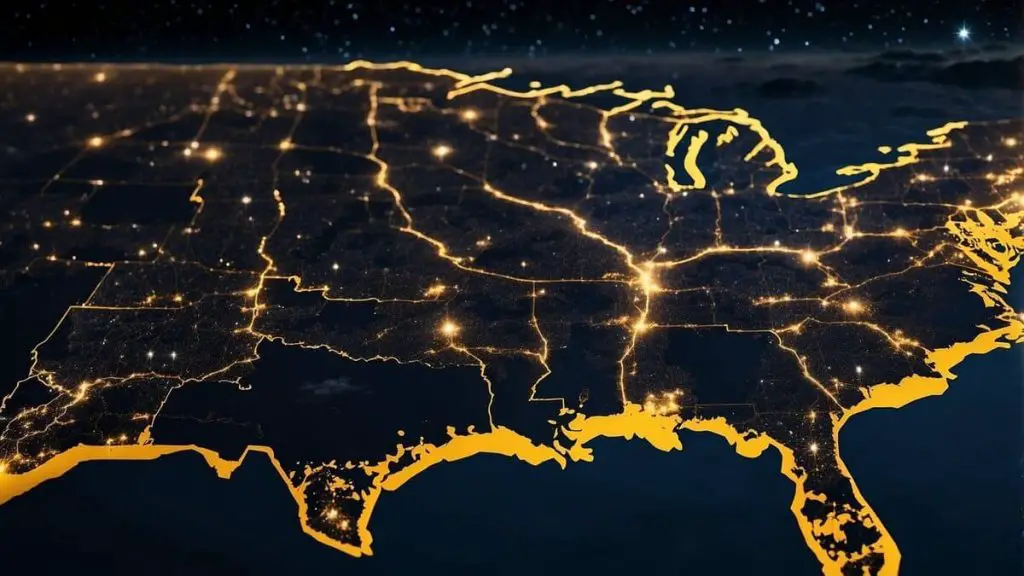
Knowing where to find the best dark skies is vital if you love stargazing. With the correct maps and community help, you can view stars from Minnesota’s beautiful dark sky areas.
Maps and Apps for Stargazing
Minnesota offers some great places for viewing the night sky. The Minnesota dark sky map guides you to the darkest spots for the best stargazing. You’ll want to head to areas like Cook County or Lake Superior for clear views:
- Minnesota Dark Sky Map: Pinpoints low light pollution areas.
- Stargazing Apps: Help you identify constellations and planets in the night sky.
Tips for using navigational tools:
- Check the dark sky map before your trip.
- I often use a stargazing app to plan my night sky observations, which enhances the experience.
- Remember, places like the Northwest Angle and Quetico Provincial Park are great for a night’s adventure.
Educational Resources and Community Engagement
Aside from maps, get involved with local stargazing groups in the Twin Cities or online forums like spaceweather.com for daily space news, including satellite sightings.
Here are some ways to learn and get involved:
- Join local astronomy clubs for events and sessions.
- Visit educational websites to learn about the night sky.
- Subscribe to newsletters for stargazing tips and space weather updates.
Using these resources, you can deepen your knowledge and enjoy the beauty of Minnesota’s night skies. Whether in a canoe on Lake of the Woods or observing from a park in Cook County, the stars are yours to explore.
Frequently Asked Questions
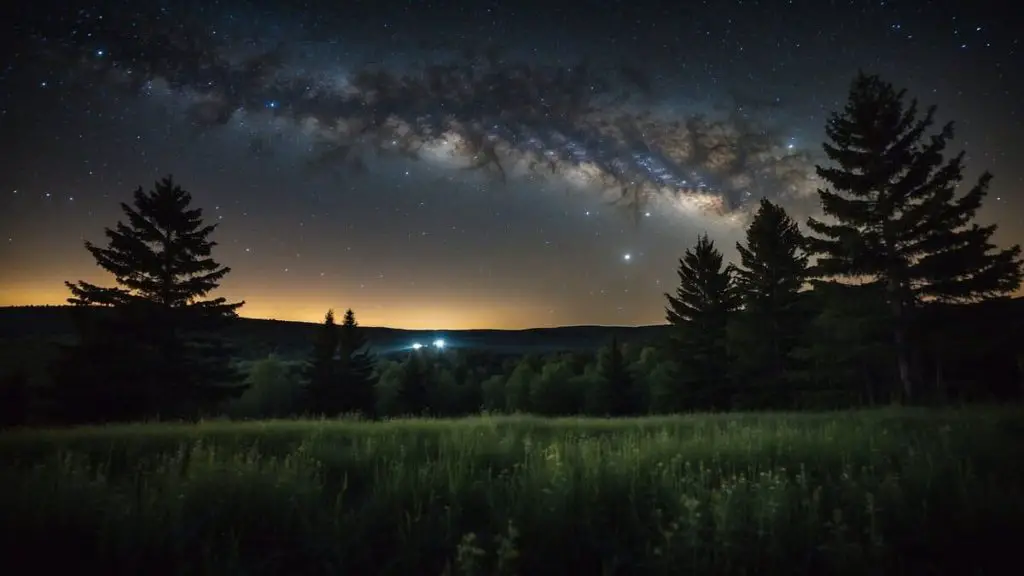
Can I still enjoy stargazing in Minnesota during the winter months?
Yes, stargazing in Minnesota is a year-round activity, including in winter. The colder months often bring clearer skies, enhancing visibility. Dress warmly and choose spots like Voyageurs National Park for breathtaking winter night skies.
Are there any beginner-friendly telescopes you recommend for starting astrophotography in Minnesota?
I recommend telescopes like the Celestron NexStar 130SLT or the Orion SkyQuest XT8 for beginners in astrophotography in Minnesota. These models offer a good balance between usability and quality, perfect for capturing Minnesota’s dark skies.
How can I participate in preserving Minnesota’s dark skies?
You can contribute to preserving Minnesota’s dark skies by using outdoor lighting responsibly, supporting local dark sky initiatives, and spreading awareness about light pollution. Small actions like using shielded lights and reducing unnecessary outdoor lighting can significantly impact.
TL;DR
- Minnesota’s Dark Sky Initiatives, led by the IDA, protect night skies for optimal stargazing experiences.
- Certified Dark Sky Places like Voyageurs National Park offer unparalleled views of the stars.
- Proper night photography techniques and equipment are essential for capturing Minnesota’s stunning night skies.
- The impact of light pollution is significant, but conservation efforts and individual actions can help reduce it.
- Seasonal astronomical events and local stargazing resources provide ample opportunities for enthusiasts to explore the night sky in Minnesota.
I love sharing my passion for the night sky and learning from the experiences of others.
I’d be thrilled to hear from you if you have any questions or want to share your stargazing stories.
Please leave your questions and comments below, and let’s keep the conversation shining!




